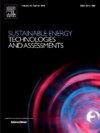Ultra-short sequence-augmented power system transient stability assessment using transformer-based deep learning
IF 7.1
2区 工程技术
Q1 ENERGY & FUELS
Sustainable Energy Technologies and Assessments
Pub Date : 2025-07-09
DOI:10.1016/j.seta.2025.104432
引用次数: 0
Abstract
The increasing penetration of renewable energy into power grids has intensified concerns regarding transient stability. Traditional transient stability assessment methodologies, which rely on time domain simulations and energy function-based approaches, face significant limitations in computational efficiency and real-time applicability. To address these challenges, this paper proposes a novel dual-phase framework that integrates Long Short-Term Memory (LSTM) networks and a modified Transformer architecture for enhanced transient stability evaluation. In the first phase, an LSTM-based trajectory reconstruction module is employed to extrapolate complete 5-second dynamic trajectories from initial measurements of 0.5 s post-fault. This addresses the critical issue of temporal data insufficiency during the early stages of system perturbations, enabling accurate representation of electromechanical transients. The second phase employs a Transformer classifier, which processes the reconstructed trajectories to assess system stability. The Transformer’s architecture incorporates tailored positional encoding to align with the frequency and timescale characteristics of system dynamics, while its self-attention mechanism facilitates the extraction of global temporal patterns essential for stability classification. A case study on the IEEE 39-bus system demonstrates the efficacy of the proposed framework. Within the critical post-fault assessment window, the method achieves an accuracy of 99.6%, significantly outperforming conventional methods in both computational efficiency and classification accuracy.
基于变压器深度学习的超短序列增强电力系统暂态稳定评估
可再生能源越来越多地渗透到电网中,加剧了对暂态稳定性的关注。传统的暂态稳定评估方法依赖于时域模拟和基于能量函数的方法,在计算效率和实时性方面存在明显的局限性。为了解决这些挑战,本文提出了一种新的双相框架,该框架集成了长短期记忆(LSTM)网络和改进的变压器架构,以增强暂态稳定性评估。在第一阶段,利用基于lstm的轨迹重建模块,从故障后0.5 s的初始测量数据中推断出完整的5秒动态轨迹。这解决了系统扰动早期阶段时间数据不足的关键问题,使机电瞬态的准确表示成为可能。第二阶段采用变压器分类器,对重建的轨迹进行处理以评估系统的稳定性。Transformer的架构结合了定制的位置编码,以配合系统动力学的频率和时间尺度特征,而其自关注机制有助于提取稳定性分类所必需的全局时间模式。以IEEE 39总线系统为例,验证了该框架的有效性。在关键的故障后评估窗口内,该方法的准确率达到99.6%,在计算效率和分类准确率上都明显优于传统方法。
本文章由计算机程序翻译,如有差异,请以英文原文为准。
求助全文
约1分钟内获得全文
求助全文
来源期刊

Sustainable Energy Technologies and Assessments
Energy-Renewable Energy, Sustainability and the Environment
CiteScore
12.70
自引率
12.50%
发文量
1091
期刊介绍:
Encouraging a transition to a sustainable energy future is imperative for our world. Technologies that enable this shift in various sectors like transportation, heating, and power systems are of utmost importance. Sustainable Energy Technologies and Assessments welcomes papers focusing on a range of aspects and levels of technological advancements in energy generation and utilization. The aim is to reduce the negative environmental impact associated with energy production and consumption, spanning from laboratory experiments to real-world applications in the commercial sector.
 求助内容:
求助内容: 应助结果提醒方式:
应助结果提醒方式:


